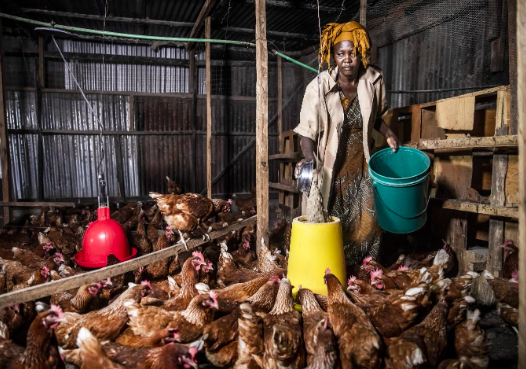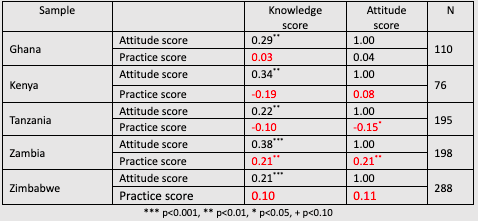
Context: AMR and AMR in Africa
The challenges of AMR are particularly striking in Africa and other low- and middle-income countries (LMICs). Burdens of infectious disease, those capable of developing resistance, remain high in both people and livestock. In addition, large segments of populations within Africa maintain livelihoods that result in frequent interactions between people and livestock, risking the transmission of resistance between animals and people. Indeed, genotypic studies in Africa provide evidence for the transmission of AMR across people, animals and the environment (Afema et al., 2016; Guenther et al., 2011; Katakweba et al., 2015). Consequently, AMR is expected to have profound public health impacts and downstream impacts on economic productivity throughout Africa and other low- and middle-income regions (Jonas, et al., 2017; O’Neil, 2016).
Assessment of these potential impacts, however, is constrained by a lack of data. Compared to high-income countries, limited data exist on patterns of AMR and antimicrobial use (AMU) in public or animal health. In the animal health sector, studies generally find that farmers administer antimicrobials themselves, mostly without prescriptions or input from animal health professionals, and engage in other non-prudent practices, such as not observing antimicrobial withdrawal periods (Auta et al., 2018; Caudell et al., 2017, 2020; Johnson et al., 2019; Ojo et al., 2016), the period of time before slaughter when treatments for the animal must cease in order to effectively eliminate them from the animal’s system.
Even when the AMR and AMU picture becomes clearer, Africa will continue to face difficulties in addressing AMR and non-prudent AMU. The combined realities of underfunded public and veterinary healthcare systems and limited regulatory capacities in most African contexts constrain efforts to promote prudent antimicrobial use and control of AMR (Bebell & Muiru, 2014; Cox et al., 2017; Founou et al., 2016; Okeke et al., 2005). Under resourced regulatory authorities (e.g., national medicines regulatory authorities, food safety departments) render national regulations, such as laws mandating prescriptions for antimicrobials or regulations on antimicrobial residues, difficult to enforce and this (i.e. inability to regulate residues) can have a significant impact on trade (Okeke et al., 2005).
Improving poultry farming practices through experiential learning and behavioural science
The gap between knowledge and behaviour
Every morning, Margaret Wanjiku checks on her flock of layer chickens hoping to find many eggs. To Margaret and her family, every egg counts. Egg sales put food on the table and pay school fees. However, Margaret’s ability to make a living off her birds is being threatened by rising production costs. Profit margins are dwindling due to uncertainties in the supply of day-old chicks and increasing prices for poultry feeds. Margaret’s egg cooperative is often undercut by competition from neighbouring countries.
Faced with growing economic and social pressures, Margaret feels forced to abandon certain farming practices that she learned during a training provided by her local animal health worker. She knows that the footbath at the door of the poultry house must be kept filled with clean disinfectant solution. However, the high costs of regularly refilling the footbath mean it often remains dirty. She also knows that her birds should be vaccinated against certain diseases, but instead she waits to hear about disease outbreaks before spending money. If her birds get sick, she gives them antibiotics, which are easier to access at local drug shops. While knowing she should get a prescription, she notices that most other farmers in her community buy drugs without prescriptions and administer them without veterinary advice. She struggles to justify paying the veterinarian for a visit or the lab for a diagnosis when no one else seems to pay these costs.
Margaret’s behavioural responses to the pressures of livestock production hold serious consequences for the emergence and transmission of antimicrobial resistance. The gap between what Margaret “knows” and how she “behaves” represents a recurrent finding in intervention research. In a study across five African countries (Ghana, Kenya, Tanzania, Zambia, and Zimbabwe) we and our colleagues at the Food and Agriculture Organization of the United Nations (FAO) found that most farmers are aware of best practices, including the importance of footbaths, getting advice from trained veterinarians, and observing withdrawal period from antibiotics (i.e., the time it takes for antibiotic residues to leave animal products) (Caudell et al., 2020). Despite this awareness, many, like Margaret, do not employ these best practices. Indeed, we found that whether a farmer observed prudent practices (i.e., having a footbath, calling a veterinarian, observing withdrawal periods) was not significantly related to their knowledge and attitudes on AMU and AMR, with the exception of broiler farmers in Zambia (see Table 1 below). In short, those who knew the most about AMR and the need for prudent AMU were no more likely to engage in prudent AMU and AMR-related practices.
 Table 1. Pearson’s Correlation between KAP measures across and within countries.
Table 1. Pearson’s Correlation between KAP measures across and within countries.
Non-significant associations are indicated with red test. Further details on development of knowledge, attitude, and practice scores can be found in Caudell et al 2020.
Closing the gap using experiential learning and behavioural science
Theories of change and models of behaviour have traditionally focused on rational, conscious, or planned changes in behaviour as the result of attempts to maximize utility. However, research from the social and behavioural sciences (including anthropology, behavioural economics, social psychology, and neuroscience) has provided compelling evidence of the limitations of rational thought and conscious decision making on actual behaviour change. Through applied social and behavioural science, researchers study what drives behaviour in order to use those drivers to influence said behaviour via rigorous scientific experimentation, analysis and iteration (Kahneman, 2011)
Moreover, behavioural scientists have identified several social and cognitive factors that help account for the gap between knowledge and behaviour highlighted above. People are heavily influenced by their social circle; they prefer to be part of the majority. When most farmers do not employ best practices, this makes it naturally harder for an individual to choose new behaviours that would make them the outlier (i.e. not part of the herd) (Cialdini et al., 2006).
Cognitive factors driving the gap between knowledge and behaviour include “hyperbolic discounting” and “status quo bias”. Hyperbolic discounting refers to people preferring small gains today over larger gains in the future (Loewenstein & Prelec, 1992). It can lead to farmers opting for cheaper solutions in the immediate term even if they know investing in disease-resilient farming would reap higher rewards in the long term. Status quo bias refers to the idea that it takes extra cognitive energy to choose a behaviour that represents a significant change from past behaviours (Kahneman et al., 1991). People tend to keep doing what they have always done instead of finding new solutions. Therefore, if a way of raising chickens or treating disease has always worked for a farmer, he/she is less open to trying a new method.
At FAO we have been drawing upon behavioural sciences, including anthropology and behavioural economics, to develop, design, and deploy interventions to limit AMR. We have conducted knowledge, attitudes, and practices (KAP) surveys among farmers to document antimicrobial use and biosecurity practices and then to identify the cultural, economic, and historical drivers of these practices. Results from these surveys have been used to develop training curriculums for farmer field schools (FFSs) to address AMR in Ghana, Kenya, Zambia, and Zimbabwe. FFSs gather 10–20 farmers on a demonstration farm. Meeting on a weekly or biweekly basis across an entire production period (e.g., 6–8 months for layer chickens), farmers analyse their production ecosystems, identify present and emerging problems and design and experiment with good practices and new farming techniques through experiential learning. This learn-by-doing approach is also strengthened by FAO’s application of insights from behavioural economics to the FFS model using the Easy, Attractive, Social, and Timely (EAST) framework (Behavioural Insights Team, 2014).
Conclusion
As with other LMIC regions, Africa faces serious health and economic threats from AMR. Given enforcement of top-down solutions (e.g., antimicrobial regulations) will remain difficult, bottom-up interventions targeted at the farm-level will be important in promoting prudent AMU and other practices to limit the emergence and transmission of AMR. In promoting these behavioural changes, conventional awareness raising strategies, those based upon the assumption that ‘filling’ gaps in knowledge will produce behavioural change, are likely to prove ineffective given structural and economic constraints often play a more important role in patterning behaviour than knowledge deficits. In addition, a lack of data on the drivers of AMU and AMR in many African contexts hampers the development of behavioural change interventions. To overcome these challenges will require novel and creative methods to promote changes in behaviour and further changes in the social and structural contexts in which these behaviours occur. For example, while behavioural insights may help to promote biosecurity practices, the long-term sustainability of these practices will ultimately be decided by social pressures that encourage such practices (e.g., fellow farmers who also follow these practices) and a business environment that rewards these practices (e.g., farmers getting a better price for their products if maintaining a certain level of biosecurity on their farms). Here, we have discussed our approach that uses results of KAP surveys and insights from behavioural economics to design FFS that allow farmers opportunities to modify their practices in ways that reduce the emergence and selection of AMR and increase farm productivity and profits.
Points of discussion
Reflect upon how to apply the EAST framework’s four principles to a specific case study of particular interest to the students. Think of concrete ways under each of the principles to facilitate behavioural change in a practical manner:
Make it Easy:
– Make an option the default to make it more likely to be adopted.
– Reduce the effort required to perform an action to increase uptake.
Make it Attractive:
– Draw attention to a behaviour (e.g., with colours) to make it more palatable.
– Make incentives enjoyable (e.g., lotteries) to boost compliance.
Make it Social:
– Describe what most people do to encourage others to follow.
– Use public commitments to make follow through more likely.
Make it Timely:
– Prompt people to change when they are most receptive.
– Ensure immediate costs do not outweigh immediate benefits.
– Work with stakeholders to plan for change.
Discuss how in the specific case of the Farmer Field Schools (FFSs) intervention the EAST framework could be operationalized.
Think about the limitations of conventional awareness raising strategies; do you think the emphasis on rational choice is valid in your experience?
Discuss with the students whether they can describe examples of “hyperbolic discounting” and/or “status quo bias” from within their own personal or professional lives.
Pedagogical notes
Regional Coordinator for the Social Sciences of AMR, Food and Agriculture Organization of the United Nations, Nairobi, Kenya.
Lead for Behavioural Science, Office of Innovation, Food and Agriculture Organization of the United Nations, Rome, Italy.
National AMR Coordinator, Food and Agriculture Organization of the United Nations, Nairobi, Kenya
AMR Project Coordination and Technical Support Expert, Food Systems and Food Safety Division, Food and Agriculture Organization of the United Nations, Rome, Italy.